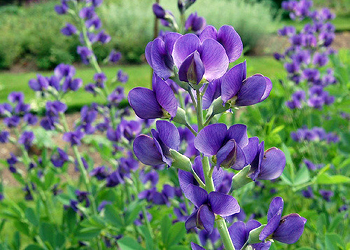Deer Resistant Plants for Pollinators

A doe munches on a butterfly garden; photo by Kerry Wixted
In sections of Maryland, high concentrations of white-tailed deer have created a demand for “deer proof” plants. In reality, though, there is no such thing. Deer may nibble on anything once, especially when hungry, but they do dislike aromatics, prickly leaves and thorns.
Unfortunately, many of the “deer proof” plants offered at stores include invasive species, such as the commonly planted Japanese barberry (Berberis thunbergii). The lack of browsing by deer aids barberry in its spread into natural areas where it outcompetes native plants and fosters habitat for ticks.
A better alternative to planting invasive species is to look for Maryland native plants that are deer resistant.
Got Sun?
Butterflyweed (Asclepias tuberosa), common milkweed (A. syrica) and swamp milkweed (A. incarnata) have a sticky, milky sap that often deter deer. These host plants for Monarch butterfly caterpillars also have beautiful flowers that attract many other butterflies and pollinators.

Butterflyweed; photo by Kerry Wixted
Butterflyweed thrives in drier conditions, while swamp milkweed, as its name implies, enjoys more moist soils. If you have a larger yard and enjoy a natural look, common milkweed is a vigorous, tall plant that spreads. It is a favorite of the Monarch caterpillar, as the large leaves provide plenty of food.
Wild bergamot (Monarda fistulosa) and other Monarda species are reliably deer resistant and have exceptionally showy, long blooming flowers. A versatile clumping plant that spreads, wild bergamot is sometimes referred to as bee balm because of the large numbers of bees, clear wing moths and other pollinators it attracts. Wild bergamot is especially popular with bumble bees as its nectar is available all day. Bergamot is the host plant for several moths including the attractive raspberry mint pyrausta. If that wasn’t enough, wild bergamot has been seen to attract beneficial sand wasps (Bicyrtes) which are voracious predators of brown marmorated stinkbugs. For areas with moist soil, bee balm (Monarda didyma) is an alternative that attracts nectaring hummingbirds.

Wild blue indigo is a tall focal point; photo by Tim Waters Flickr CC by NC ND 2.0
One of the best behaved of our native goldenrods is wrinkle-leaf goldenrod (Solidago rugosa), a magnet for pollinators and other beneficial insects in late summer and fall. Its arching sprays of yellow flowers will help attract passing Monarch butterflies into your yard and provide fuel for their migration south. This tough plant can deal with difficult garden locations but tends to stay clumped. Leave the attractive dead flower heads through the winter so the seeds can feed birds; the hollow stalk can provide winter habitat for native bees.
Other stand out deer-resistant plants include wild blue indigo (Baptisia australis), which grows in drier soil as a shrubby focal point. It has showy spikes of blue flowers, interesting leaves and is a butterfly host plant. Sundrops (Oenothera fruticosa) truly look like drops of sun in late spring and will attract bees and hummingbirds. Happy in most soil types, it will spread but isn’t aggressive and overwinters as reddish evergreen rosette.
Got Shade?
Virginia bluebells (Mertensia virginica) is a woodland favorite with delicate pink and blue flowers in spring that attract long tongued bees. Hummingbirds have also been documented nectaring from Virginia bluebells in the spring. Bluebells die back in summer, so it is best to mix bluebells with native ferns such as cinnamon (Osmunda cinnamonea) or ostrich fern (Matteuccia struthiopteris).
Wild columbine (Aquilegia canadensis) is a versatile plant that is happy in both shade and sun. Columbine has a unique flower with spurred bells that look like little red lanterns blowing in the wind. The flowers attract hummingbirds as well as bees and butterflies. The leaves will feed insects but are toxic to mammals like deer. Occasionally, leaf miners will munch on columbine leaves, but this usually occurs later in the plant’s life cycle.

Golden ragwort is a welcome burst of color in shady spring gardens; photo by Kerry Wixted
The less well-known golden ragwort (Packera aurea) is an adaptable plant that will grow in sun or shade as long as soils are moist. It has a long bloom time and is semi-evergreen, overwintering as a basal rosette. Golden ragwort is an aggressive spreader that can be used as a groundcover especially in areas where invasive plants like English ivy have been removed. Unlike ivy, though, it will attract a wide variety of pollinators and is a host plant for the threatened northern metalmark butterfly.
Other shade options include Jack-in-the-pulpit (Arisaema triphyllum) which has unique striped flowers and large red berries. Wild blue phlox (Phlox divaricata) has showy aromatic flowers, is evergreen and will spread slowly in moist woods. However, it can be nibbled by rabbits. Bluestem goldenrod (Solidago caesia) has delicate, yellow flowers along the stem which provide fall flowers that feed both pollinators and birds.
Additional Tips
Remember to look for the straight native varieties of plants. Cultivars or nativars available at nurseries often have given names in apostrophes like ‘Little Joe,’ ‘Twilite Prairieblues,’ or ‘Pink Double Delight.’ These plants have been bred for showier flowers or leaves, but the changes that make these plants attractive to people can also make them unappealing to pollinators. The cultivar flowers may be sterile, lacking pollen and/or nectar, which means they don’t provide any food for visiting bees or butterflies. Altering the flower shape may make its nectar unavailable to a pollinator, while variegated or red leaves may appeal less to butterfly caterpillars.
Finally, be aware that deer are resourceful creatures and will try any new plant that appears in your yard to see how it tastes. If enough passing deer take a nibble, even resistant plants can be killed. It is best to protect any new plants until they are established with deer repellent sprays or fencing. The urge to try just a bite can return when flowers first appear, so in areas with high deer densities, you may need a second spray.
Article by Clare Walker.
Author’s Note
Spring has finally sprung! After a seemingly endless winter, I am excited to welcome warmer temperatures, spring flowers and wildlife into my backyard. This issue includes information on spring visitors like flower flies—a pollinator and a predator—as well as a beautiful native groundcover, moss phlox.
In addition, spring is a time for migration, which can be hazardous for many birds. Check out our article on bird-safe windows for tips on how to make your home more bird-friendly as well as some recommendations by guest author, Clare Walker, on plants that help pollinators but often deter deer.
If there is a particular topic that you would like to include, please don’t hesitate to reach out.
Happy Habitats!
Kerry Wixted
Click here to have HabiChat—the quarterly backyard wildlife habitat newsletter from the Wild Acres program—delivered right to your inbox!
In this Issue:
Bird Safe Windows
Deer Resistant Plants for Pollinators
Flower Flies
Moss Phlox


 1-888-373-7888
1-888-373-7888 233733
233733